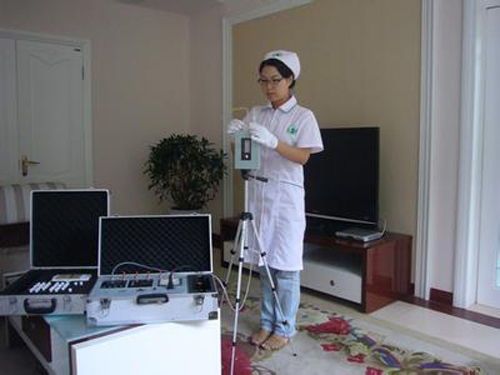How to detect indoor air quality?

With the improvement of people's indoor environmental awareness, people are increasingly concerned about the influence of the indoor environment on themselves and their family members' health. So, how do you judge that the environment in which you and your family live and work is safe and healthy? Then do indoor air testing!
Indoor air detection content to be detected:
First, formaldehyde
Formaldehyde is colorless and has a strong odor. Formaldehyde-based irritant gas, its 35% to 40% of the aqueous solution known as formalin. -92 ° C melting point, boiling point -21 ° C, the density of the liquid when the 0.815 g / 3 cm (20 ° C). Formaldehyde is a toxin of the original pulp and can bind to proteins. After inhaling high concentrations of formaldehyde, severe respiratory irritations, edema, eye irritation, and headache can occur. Bronchial asthma can also occur. Direct contact with formaldehyde on the skin can cause dermatitis, pigmentation, and necrosis. Frequent inhalation of small amounts of formaldehyde can cause chronic poisoning, mucosal congestion, skin irritation, allergic dermatitis, keratinization and fragility of nails, and pain at the end of the nail bed. Systemic symptoms include headache, fatigue, appetite, palpitations, insomnia, weight loss, and autonomic disorders. Long-term exposure to low-dose formaldehyde can cause chronic respiratory diseases, menstrual disorders, and pregnancy syndrome, which can lead to reduced physical fitness and chromosome abnormalities. It even causes nasopharyngeal cancer. High concentrations of formaldehyde are toxic to the nervous system, the immune system, and the liver. Formaldehyde also has teratogenic and carcinogenic effects. People who have long-term exposure to formaldehyde may cause cancers such as nasal cavity, oral cavity, nasopharyngeal, throat, skin and digestive tract.
Formaldehyde can be contained in various artificial boards (particle board, fiber board, plywood, etc.) due to the use of a binder. The production of new furniture, wall and floor decoration, use adhesives. Wherever adhesives are used in large quantities, formaldehyde is always released. In addition, some chemical fiber carpets and paints also contain a certain amount of formaldehyde. Formaldehyde can also come from cosmetics. Cosmetics, detergents, insecticides, disinfectants, preservatives, printing inks, paper, textile fibers and many other chemical light industrial products.
Second, benzene
Benzene is a colorless liquid with a special aromatic odor. It has a melting point of 5.5°C and a boiling point of 80.1°C. It is soluble in alcohol, ether, acetone and carbon tetrachloride and slightly soluble in water. Benzene is volatile, flammable, and its vapor is explosive. Often exposed to benzene, the skin may become dry due to defatting, desquamation, and some appear allergic eczema. Prolonged inhalation of benzene can cause aplastic anemia. Benzene vapor is toxic, and acute poisoning can cause cramps and even loss of consciousness in severe cases; chronic poisoning can damage hematopoietic function. Benzene is mainly derived from a large number of chemical raw materials used in architectural decoration, such as paints, wood lacquers, adhesives and various organic solvents. In the process of film formation and curing of the coating, volatile components such as formaldehyde and benzene contained therein are released from the coating and cause contamination.
Third, TVOC
TVOC is also known as total volatile organic compounds. Among them, volatile organic compounds are commonly referred to as VOCs. It is an abbreviation for the first letter of the three words Volatile Organic Compound, but is sometimes also expressed by TVOC, a total volatile organic compound.
TVOC is one of the more serious types of airborne organic pollutants (PAHs, VOCs, and aldehydes). VOC refers to an organic substance whose saturated vapor pressure exceeds 133.32 MPa at room temperature. Its boiling point is in the range of 50° C. to 250° C., and it can be evaporated in the form of air at room temperature. Its toxicity, irritation, carcinogenicity and special odor. It affects the skin and mucous membranes and causes acute damage to the human body. Some compounds in TVOC are genotoxic.
Indoor TVOC total volatile organic compounds include: benzene, toluene, p-xylene, m-xylene, o-xylene, styrene, ethylbenzene, butyl acetate, undecane, and the like.
In addition to the above three toxic substances, there are toluene, xylene, nitrogen, helium and so on.
Standard House Nipple,Custom Stainless Hose Nipple,Good Use Steel Hose Nipple,Tube Fittings
SHAOXING OGAWA PIPE CO.,LTD. , https://www.sxogawapipe.com